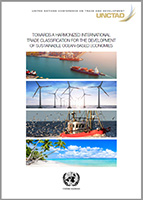
The vital importance of the oceans for human life and the development of livelihoods is recognized in Sustainable Development Goal 14 (life below water) and its traderelated targets, as well as in subsequent national and international declarations.
Meeting these ambitious targets and objectives will require coherent policies at the sectoral, national and international levels with regard to production, trade and the environment. So far, most initiatives for attaining Goal 14 have focused on the sustainability of ocean ecosystems and ocean management. Limited work has been done on the identification of ocean-based sectors and assessment of their economic relevance: only a handful of countries have developed a classification that identifies the key sectors and subsectors that fall within the purview of an ocean economy. Only a few regional and international initiatives have attempted to map and measure the ocean economy, and modest international funds have been devoted to the development of ocean economy and trade strategies. The assessment and mapping of ocean-based sectors requires technical expertise and resources, a task that is hindered by the lack of an international classification of goods and/or services that can be directly applied to mapping ocean economy sectors.
This publication aims to lay a foundation for filling information and data gaps in trade in ocean-based sectors to facilitate its sustainable development within and across borders.
The publilcation proposes a sustainable ocean economy classification for tradable goods and services that can be used by all countries at any time. It has been conceptualized considering its application for the design of coherent policies, the assessment of the pillars of sustainable ocean development and the comprehensive analysis of the value chains as part of the ocean-based sectors (goods and services).
The main principles on which the classification is based are similar to those of any other international classifications of goods and services – applicability, standardization, comprehensiveness and flexibility.
The proposed classification builds on the work of regional and international organizations to assess ocean-based sectors. It also takes into account national ocean economy classifications, the structure of existing international classifications of goods and services, lessons learned from the implementation of ocean economy trade strategies of the United Nations Division for Ocean Affairs and the Law of the Sea and UNCTAD, the UNCTAD Oceans and Fisheries Programme and the UNCTAD blue biotrade approach and projects.
The classification presented here benefited from the guidance and inputs from experts from international organizations, the private sector, Governments, academia and civil society.
The classification features three categories: goods, services and energy. Each category is divided into chapters (A-M), and each chapter is subdivided into a three-digit level of detail covering 52 subsectors.
The classification sectors are as follows:
- Marine fisheries
- Aquaculture and hatcheries
- Seafood processing
- Sea minerals
- Ships, port equipment and parts thereof
- High-technology and other manufactures not elsewhere classified (NEC)
- Marine and coastal tourism
- Trade in fisheries services
- Maritime transport and related services
- Port services, related infrastructure services and logistical services
- Coastal and marine environmental services
- Marine research and development and related services
- Ocean energy and renewable energy




